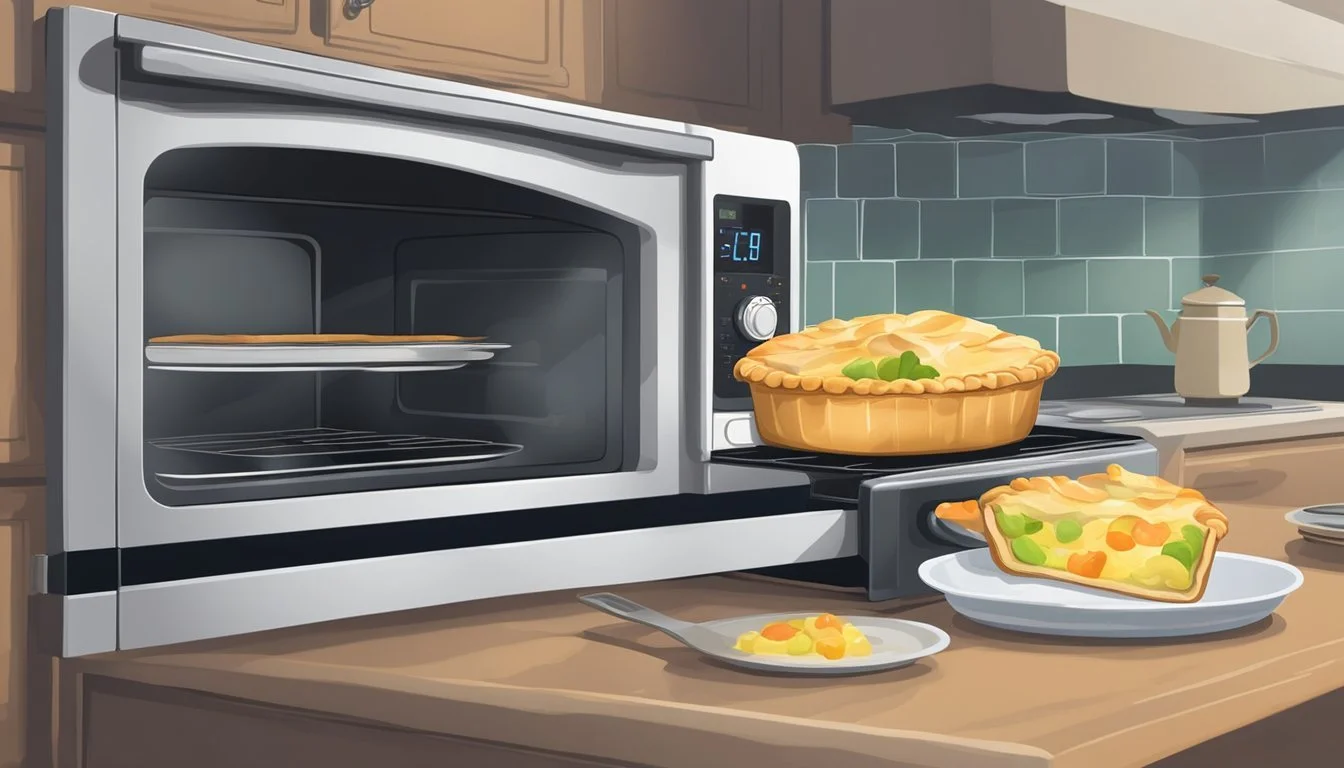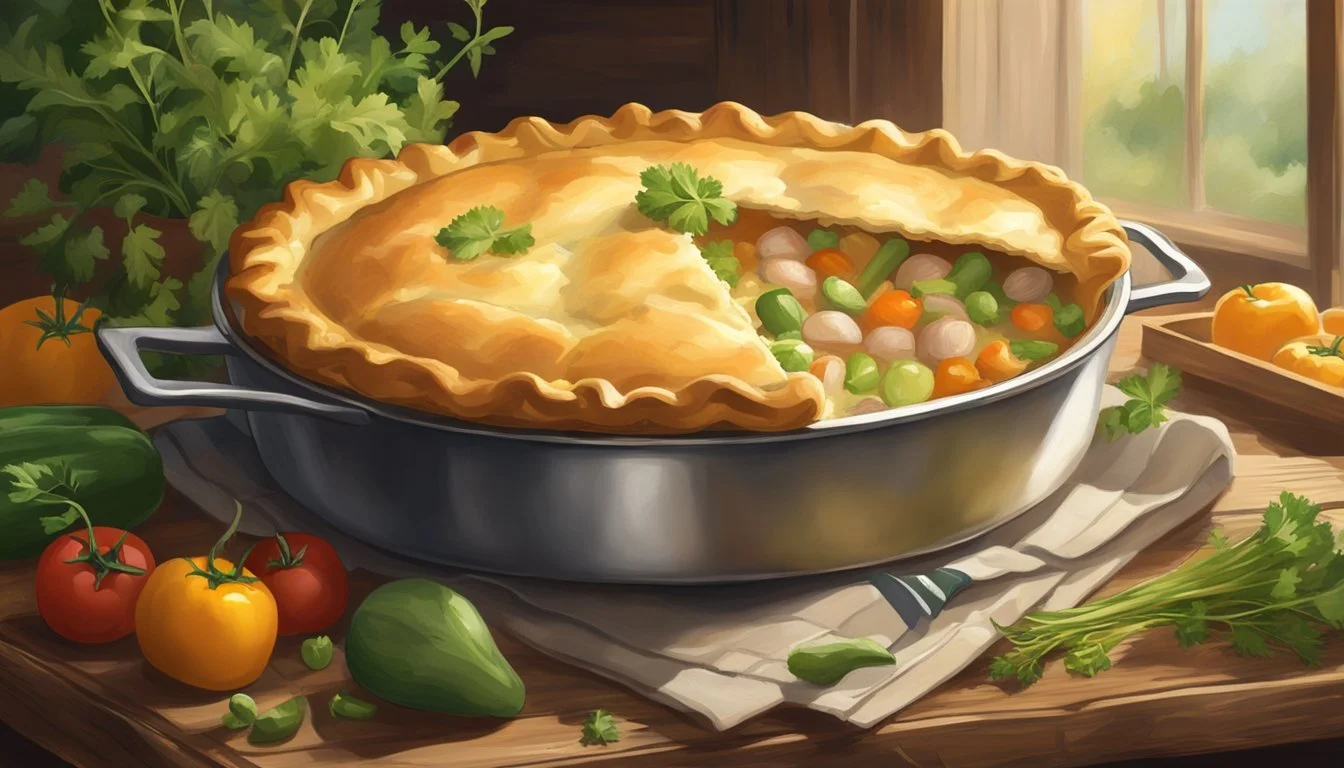How Long Does Banquet Chicken Pot Pie Last?
Storage Tips & Shelf Life
Banquet chicken pot pies are a beloved comfort food, ideal for quick dinners or a satisfying snack. For those wondering about the shelf life of this convenient meal, the answer varies depending on storage conditions. When stored in the freezer, a Banquet chicken pot pie can last up to 18 months while maintaining optimal quality.
Once cooked, the pie should be consumed within 3-4 days if kept in the refrigerator. Always ensure the pie reaches an internal temperature of 165 degrees F to guarantee it’s safe to eat.
Proper storage and handling are key to enjoying these classic dishes for as long as possible without compromising on taste or safety. Whether you're preparing one for yourself or serving guests, knowing how long you can store and enjoy a Banquet chicken pot pie ensures you get the most out of every bite.
Understanding Pot Pies
Pot pies are savory dishes featuring a filling of meat and vegetables encased in a flaky, buttery crust. They are beloved for their comforting flavors and hearty ingredients.
Main Ingredients
A standard pot pie typically includes various meat options such as chicken, turkey, or beef.
Chicken is a popular choice, often paired with carrots, peas, and celery. The vegetables not only add nutritional value but also enhance the taste and texture.
The crust is crucial, usually made from a buttery, flaky pastry that bakes to a golden brown.
The filling is bound together with a creamy gravy, which adds richness and moisture. Herbs and spices like thyme, sage, and pepper are often incorporated to deepen the flavor.
Varieties of Pot Pie
Pot pies come in several varieties, both in terms of ingredients and preparation methods.
Meat variations include chicken, beef, and turkey, each bringing its own unique flavor.
There are also vegetarian options that omit meat altogether, focusing on a range of vegetables and plant-based proteins.
Crust types can vary, with some pot pies featuring a double crust (top and bottom) while others may have only a top crust.
Additionally, cooking methods differ, with some pot pies baked traditionally in the oven, and others designed for quicker microwave preparation. These variations provide flexibility and cater to diverse taste preferences.
Food Safety Fundamentals
Proper food safety practices ensure that your Banquet chicken pot pie remains safe to eat and retains its quality. Key points include understanding bacteria and perishability, handling and storing the pie correctly, and identifying signs of spoilage.
Bacteria and Perishability
Bacteria such as Salmonella and E. coli can thrive in improperly stored chicken pot pies. Perishability is a key concern, as the ingredients can foster bacterial growth if not handled correctly.
Cooked chicken pot pies should be refrigerated within two hours to inhibit bacterial growth. If left at room temperature for longer, the risk of food poisoning increases significantly.
Maintaining a cold temperature below 40°F (4°C) is essential to slow bacterial activity and extend the pot pie's shelf life.
Proper Handling and Storage
For maximum safety, always store the chicken pot pie in the fridge if it will be consumed within a few days. For longer storage, freezing is recommended.
The shelf life in the refrigerator is around 3-5 days. In the freezer, Banquet chicken pot pies can last for 6-9 months at 0°F (-18°C) or lower.
Always ensure that the pie is stored in an airtight container or its original packaging to prevent contamination and freezer burn. Labeling the storage date can help keep track of freshness.
Signs of Spoilage
Identifying spoilage is crucial to avoid foodborne illness. Look for changes in color, texture, and odor as primary indicators.
If the pot pie has developed an off-putting smell or appears slimy, it's best to discard it. Mold growth is another clear sign that the pie is no longer safe for consumption.
By recognizing these signs early, you can prevent the consumption of spoiled food and protect against potential health risks.
Store-Bought Chicken Pot Pie
A store-bought chicken pot pie is a convenient and tasty meal option that comes with clear labeling and packaging for easy storage. It's essential to understand the shelf life and the packaging details to ensure you enjoy this meal at its best.
Shelf Life
Store-bought chicken pot pies, such as those from Banquet, typically last around 3 to 5 days in the refrigerator if stored properly. Frozen variations can be kept for 4 to 6 months, ensuring they remain in optimal condition.
To maintain quality, always check the label for specific storage instructions, as manufacturers provide guidance that can vary slightly. If unsure, it's safer to stick to the conservative side of the suggested time frames to avoid any risk of spoilage.
Packaging and Labeling
The packaging of store-bought chicken pot pies is designed to keep the product fresh and protected from external contaminants. Sealed boxes or wrappers generally contain all necessary information.
Key Label Indicators:
Expiration Date: Look for the "Best By" date.
Storage Instructions: Details on whether to keep it frozen or refrigerated.
Nutritional Information: Ingredients list, calorie content, and allergen warnings.
Proper packaging helps in maintaining the integrity of the food, ensuring that you enjoy the chicken pot pie safely and deliciously. Always inspect the packaging for any damage before purchase to ensure the product inside is intact.
Refrigeration and Freezing
Properly storing your banquet chicken pot pie ensures it maintains its quality and safety. Key methods include refrigeration for short-term storage and freezing for longer periods.
Refrigerating Cooked Chicken Pot Pie
Cooked chicken pot pie can be stored in the refrigerator for up to four days. To preserve freshness, place the pot pie in an airtight container. Covering it tightly with plastic wrap or aluminum foil also works well.
Refrigeration slows bacterial growth, keeping the pie safe to eat. Ensure the refrigerator temperature is set at or below 40°F (4°C).
Freezing and Defrosting Instructions
For extended storage, freeze the chicken pot pie. Place it in a freezer-safe, airtight container. Alternatively, tightly wrap it in plastic wrap and then in aluminum foil. The pie can last up to three months in the freezer.
To defrost, transfer the pie to the refrigerator the night before you plan to reheat it. For quicker defrosting, use the microwave on a low setting. Ensure the pie is heated through, either in the oven at 350°F (175°C) or in the microwave.
Homemade Chicken Pot Pie
Homemade chicken pot pie offers a comforting meal with the flexibility to freeze ahead for convenience or store efficiently for later consumption.
Storage Tips
To keep a homemade chicken pot pie fresh, handle with care after baking. Allow the pie to cool to room temperature before storing. For short-term storage, wrap the pot pie tightly with plastic wrap or aluminum foil and place in the refrigerator. It can last for up to 3-4 days.
For longer storage, use airtight containers or heavy-duty freezer bags for freezing. Properly stored, a chicken pot pie can maintain quality in the freezer for up to 4-6 months.
Making Ahead and Freezing
Making a chicken pot pie ahead of time can be a time-saver. Assemble the pie as usual but do not bake it. Instead, wrap it tightly with plastic wrap and a layer of aluminum foil. Label it with the date and freeze.
When ready to cook, there is no need to thaw. Bake directly from the freezer at 400°F (200°C) for about 60-70 minutes, or until the crust is golden brown and filling is bubbly.
For smaller portions, consider preparing individual pot pies in smaller ramekins. This allows easy reheating and minimal waste.
Additionally, keeping extra pie dough on hand and frozen portions of filling can streamline future preparations.
Cooking and Reheating Methods
To ensure the best taste and safety of Banquet Chicken Pot Pie, it's essential to use the right cooking and reheating methods. Here are detailed instructions for oven baking, microwave use, and alternative reheating options.
Oven Baking
Oven baking is a traditional and effective way to cook a Banquet Chicken Pot Pie.
Preheat the Oven: Set the oven to 375°F (190°C).
Preparation: Remove the pot pie from its packaging. Place it in a baking dish.
Baking: Put the dish in the center of the oven. Bake for 30-35 minutes for a regular-sized pie.
Check for Doneness: The crust should be golden brown. Use a meat thermometer to ensure the internal temperature reaches 165°F (74°C).
Covering the edges with foil can help prevent over-browning of the crust.
Microwave Use
Using a microwave is a quicker option for heating a Banquet Chicken Pot Pie.
Preparation: Remove the pot pie from the box and place it in a microwave-safe dish.
Microwave Settings: Set the microwave to high power.
Time: Microwave for 5-7 minutes for a regular-sized pie. This can vary based on microwave power.
Stir and Continue: Halfway through, pause to stir the filling and ensure even heating.
A microwave-safe cover or paper towel can prevent splatters.
Alternative Reheating Options
Alternative reheating options can also be considered for those without an oven or microwave.
Air Fryer:
Preheat to 350°F (175°C).
Place the pot pie in the center of the air fryer basket.
Heat for about 15 minutes for a cooled pie or 20-25 minutes for a frozen one.
Lightly coat a skillet with non-stick cooking spray.
Place the pie slice in the pan over medium heat.
Cover and heat for 10-15 minutes, occasionally checking to avoid burning the crust.
These methods should maintain the flavor and texture of the pie for a satisfying meal.
Nutritional Considerations
Banquet Chicken Pot Pie provides specific nutritional content that is important for consumers to consider. Each pie contains 350 calories. This makes it a moderate option for a meal, but it is essential to look at the macronutrient distribution as well.
The carbohydrate content of the pot pie stands at 35 grams. This includes the crust and any vegetables within the pie. For individuals monitoring their carbohydrate intake, this amount should be factored into their daily allowance.
Saturated fat is a significant component, with each pie containing 9 grams of saturated fat. Saturated fat is a type of fat that can impact cholesterol levels if consumed in large amounts. The total fat content is 21 grams, making up a considerable portion of the pie's calorie content.
In terms of protein, the pot pie offers 11 grams per serving. This provides a source of protein, though it may not be sufficient as the main protein source for more protein-heavy diets.
Here is a brief summary of the nutritional breakdown:
Nutrient Amount per Pie (198g) Calories 350 Carbohydrates 35 grams Saturated Fat 9 grams Total Fat 21 grams Protein 11 grams
People should also be aware of any additional ingredients that might impact their health, such as preservatives or allergens. Reading the full nutrition label and ingredients list is recommended for those with dietary restrictions or health concerns.
Pie Crust Mastery
Achieving a flaky and delicious pie crust entails mastering the ingredients and techniques essential for creating a perfect base. Focusing on these critical aspects can elevate the quality of your homemade pies.
Crafting the Perfect Crust
To create an exceptional pie crust, technique and attention to detail are key. Keep ingredients cold to ensure a flaky texture. When handling the dough, avoid overworking it to prevent it from becoming tough. Chilling the dough after mixing, and before rolling, helps in maintaining its structure.
Using a food processor for mixing can blend the fats and flour efficiently. When rolling out the dough, lightly flour the surface and roll from the center outward, rotating the dough to maintain an even thickness. Docking the crust (creating tiny holes) allows steam to escape, preventing it from puffing up during baking.
Crust Ingredients
Flour is the foundation of any pie crust. All-purpose flour offers versatility and consistency. Fat is essential for flakiness; use butter for flavor and lard for its tenderness. A mix of both often yields the best results.
Ice water helps to bind the dough without warming it up. Some recipes may call for a bit of vinegar or lemon juice to tenderize the dough further. An egg wash (whisked egg with a bit of water) brushed on the crust prior to baking creates a golden, shiny finish.
Combining these ingredients thoughtfully equips anyone to make a crust that complements and enhances any filling, providing a delicious and reliable base for various pies.
Additional Tips and Tricks
When preparing a Banquet chicken pot pie, there are various techniques that can enhance its flavors and presentation. Knowing how to elevate its taste and serve it well can make it a memorable meal for any occasion.
Enhancing Flavors and Texture
One way to enhance the flavors of a Banquet chicken pot pie is by adding extra seasoning. Sprinkle a little garlic powder, onion powder, or thyme on the filling before cooking to boost its taste. Adding fresh or dried herbs can make a significant difference.
For a flakier crust, brush the top with beaten egg before baking. This will give the crust a nice golden-brown color and a delightful texture. If you prefer a richer flavor, consider using butter-based pastry dough as the top crust.
To improve the overall texture, ensure that the filling is not too watery. If needed, thicken the mixture with a small amount of cornstarch or flour before baking.
Enhance the pie by adding fresh or frozen vegetables such as carrots, peas, or green beans to the existing mix, providing a homemade touch and a burst of freshness.
Serving Suggestions
Banquet chicken pot pie is perfect for dinner gatherings and family meals. Serve it alongside a fresh garden salad or steamed vegetables to balance the richness of the pie.
For a more elegant presentation, consider serving the pot pie in individual ramekins. This not only makes it easier to serve but also creates a sophisticated appearance suitable for entertaining guests.
Pair the pie with a light dessert such as fruit salad or sorbet to finish the meal on a refreshing note. Drinks like iced tea or a light white wine can complement the flavors without overwhelming the palate.
If hosting a more casual gathering, the pot pie can be served casserole-style, allowing guests to help themselves. This approach is particularly well-suited for a buffet setup or a potluck dinner.










